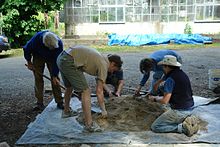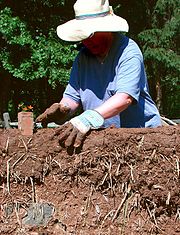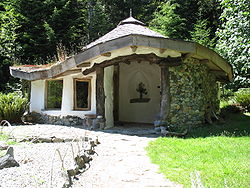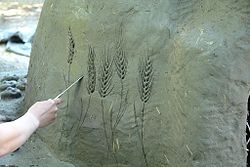- Cob (material)
-
Cob or cobb or clom (in Wales) is a building material consisting of clay, sand, straw, water, and earth, similar to adobe. Cob is fireproof, resistant to seismic activity,[1] and inexpensive. It can be used to create artistic, sculptural forms and has been revived in recent years by the natural building and sustainability movements.
Contents
History and usage
 Cob building is usually a highly cooperative activity, as seen here at the University of Washington's construction of a cob oven
Cob building is usually a highly cooperative activity, as seen here at the University of Washington's construction of a cob oven
Cob is an ancient building material, that may have been used for construction since prehistoric times. Some of the oldest man-made structures in Afghanistan are composed of rammed earth and cob.[2] Cobwork (tabya) was used in the Maghreb and al-Andalus in the 11th and 12th centuries and was described in detail by Ibn Khaldun in the 14th century.[3]
Cob structures can be found in a variety of climates across the globe; In the UK it is most strongly associated with counties of Devon and Cornwall in the West Country; the Vale of Glamorgan and Gower Peninsula in Wales; Donegal Bay in Ulster and Munster, South-West Ireland; and Finisterre in Brittany where many homes have survived over 500 years and are still inhabited.[citation needed] Many old cob buildings can be found in Africa, the Middle East, Wales, Devon, Cornwall, Brittany and some parts of the eastern United States.[citation needed] A number of cob cottages survive from mid-19th century New Zealand.[citation needed]
Traditionally, English cob was made by mixing the clay-based subsoil with sand, straw and water using oxen to trample it. The earthen mixture was then ladled onto a stone foundation in courses and trodden onto the wall by workers in a process known as cobbing.[citation needed] The construction would progress according to the time required for the prior course to dry. After drying, the walls would be trimmed and the next course built, with lintels for later openings such as doors and windows being placed as the wall takes shape.[citation needed]
The walls of a cob house were generally about 24 inches thick, and windows were correspondingly deep-set, giving the homes a characteristic internal appearance. The thick walls provided excellent thermal mass which was easy to keep warm in winter and cool in summer.[citation needed] Walls with a high thermal mass value act as a thermal buffer inside the home.[citation needed] The material has a long life span even in rainy climates, provided a tall foundation and large roof overhang are present.[citation needed]
Modern cob buildings
When Kevin McCabe built a two-story, four bedroom cob house in England in 1994, it was reputedly the first cob residence built in the country in 70 years. His methods remained very traditional; the only innovations he added were using a tractor to mix the cob itself, and adding sand or shillet (a gravel of crushed shale) to reduce the shrinkage.
From 2002 to 2004, sustainability enthusiast Rob Hopkins initiated the building of a cob house for his family, the first new one in Ireland in about one hundred years. It was undertaken as a community project, but destroyed by an unknown arsonist shortly before completion.[4] This house, located at The Hollies Centre for Practical Sustainability in County Cork, is being rebuilt (2010). There are also a number of other modern cob houses completed and more planned including a public education centre.[5]
In 2000-2001, a modern, four-bedroom cob house in Worcestershire, UK designed by Associated Architects was sold for £999,000. Cobtun House was built in 2001 and won the Royal Institute of British Architects' Sustainable Building of the Year award in 2005. The total construction cost was £300,000, but the metre-thick cob outer wall cost only £20,000.
In the Pacific Northwest of the US there has been a resurgence of cob building both as an alternative building practice and one desired for its form, function and cost effectiveness. There are more than ten cob houses in the Southern Gulf Islands of British Columbia built by Pat Hennebery, Tracy Calvert, Elke Cole and the Cobworks workshops.
In 2007, Ann and Gord Baird began constructing a two-story cob house in Victoria, British Columbia for an estimated $210,000 CDN. The 2,150 sq. ft. home includes heated floors, solar panels and a southern exposure for passive solar heating.[6]
The building process known as "Oregon Cob" is one which was refined by Welsh architect Ianto Evans and researcher Linda Smiley in the 1980s. Oregon Cob integrates the variation of wall layup technique which uses loaves of mud mixed with sand and straw with a rounded architectural stylism.[7][8]
See also
- Sustainable development portal
- Appropriate technology
- ARGE-SH, a German Research-Institute for Cob-buildings
- Chirpici (a variant of cob used in southern Romania)
- Compressed earth block
- Earthship, A building created using rammed earth techniques.
- LOHAS
- Mud and stud
- Mudbrick
- Rammed earth
- Rice-hull bagwall construction
- Sod
- Sod house
- Straw-bale construction
- Super Adobe
- Woodway House A typical Devon cob building
Notes
- ^ Goodnow, Cecelia (October 5, 2007). "Thinking of building a cob home?". Seattle Post-Intelligencer. http://www.seattlepi.com/lifestyle/article/Thinking-of-building-a-cob-home-1251753.php.
- ^ McArdle, Patricia (June 19, 2011). "Afghanistan’s Last Locavores". The New York Times. http://www.nytimes.com/2011/06/20/opinion/20mcardle.html?_r=2.
- ^ p. 766, Engineering, Donald Routledge Hill, pp. 751–795, in Encyclopedia of the history of Arabic science, vol. 3, Roshdi Rashed and Régis Morelon, eds., Routledge, 1996, ISBN 0-415-02063-8 (3 vol. set).
- ^ Practical Sustainability: About
- ^ Welcome to The Hollies (2010-08-03). "The Hollies". Theholliesonline.com. http://theholliesonline.com. Retrieved 2010-12-04.
- ^ Barton, Adriana (2007-08-03). "A Dream Home Made of Mud". The Globe and Mail (The Globe and Mail). http://www.theglobeandmail.com/servlet/story/RTGAM.20070803.wlcob/BNStory/lifeHouseHome/?page=rss&id=RTGAM.20070803.wlcob. Retrieved 2008-09-26.
- ^ The History of Cob
- ^ Building with Oregon Cob
Further reading
- Building With Cob, A Step by Step Guide by Adam Weismann and Katy Bryce. Published by Green Books ; 2006, ISBN 1-903998-727.
- The Hand-Sculpted House: A Philosophical and Practical Guide to Building a Cob Cottage (The Real Goods Solar Living Book) by Ianto Evans, Michael G. Smith, Linda Smiley, Deanne Bednar (Illustrator), Chelsea Green Publishing Company; (June 2002), ISBN 1-890132-34-9.
- The Cob Builders Handbook: You Can Hand-Sculpt Your Own Home by Becky Bee, Groundworks, 1997 ISBN 9780965908207
External links
Categories:- Construction
- Building materials
- Sustainable building
- Appropriate technology
- Natural materials
- Rammed earth
- Soil
- Sustainable products
Wikimedia Foundation. 2010.



